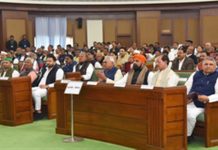 The Economic Survey on Friday projected India’s economic growth at 6 per cent to 6.5 per cent in 2020-21, and it asks the Government to use its strong mandate to deliver expeditiously on reforms, which will enable the economy to strongly rebound in 2020-21.
The Economic Survey on Friday projected India’s economic growth at 6 per cent to 6.5 per cent in 2020-21, and it asks the Government to use its strong mandate to deliver expeditiously on reforms, which will enable the economy to strongly rebound in 2020-21.
The Survey points out that the year 2019 was a difficult year for the global economy with world output growth estimated to grow at its slowest pace of 2.9 per cent since the global financial crisis of 2009, declining from a subdued 3.6 per cent in 2018 and 3.8 per cent in 2017. Uncertainties, although declining, are still elevated due to protectionist tendencies of China and USA and rising USA-Iran geo-political tensions. Amidst a weak environment for global manufacturing, trade and demand, the Indian economy slowed down with GDP growth moderating to 4.8 per cent in first half of 2019-20, lower than 6.2 per cent in second half of 2018-19. A sharp decline in real fixed investment induced by a sluggish growth of real consumption has weighed down GDP growth from 2nd half of 2018-19 to 1st half of 2019-20.
In an attempt to boost demand, 2019-20 has witnessed significant easing of monetary policy with the repo rate having been cut by RBI by 110 basis points. Having duly recognized the financial stresses built up in the economy, the government has taken significant steps this year towards speeding up the insolvency resolution process under Insolvency and Bankruptcy Code (IBC) and easing of credit, particularly for the stressed real estate and Non-Banking Financial Companies (NBFCs) sectors. At the same time, impact of critical measures taken to boost investment, particularly under the National Infrastructure Pipeline, present green shoots for growth in H2 of 2019-20 and 2020-21
Given India’s record of growth with macroeconomic stability over the last five years (annual average growth rate of 7.5 per cent), the economy is poised for a rebound towards the US$ 5 trillion goal by 2024-25.The net FDI and Net Foreign Portfolio Investment (FPI) in first eight months of 2019-20 stood at US$ 24.4 billion and US$ 12.6 billion respectively, more than the inflows received in the corresponding period 2018-19.
As per the latest available data on employment, there has been an increase in the share of formal employment, as captured by ‘Regular wage/salaried’, from 17.9 per cent in 2011-12 to 22.8 per cent in 2017-18. This 5 per cent points increase in the share of ‘Regular wage/Salaried’ group has been on account of 5 percentage points decrease in the share of casual workers, which reflects formalization in the economy. As a result, in absolute terms, there was a significant jump of around 2.62 crore new jobs over this period in the usual status category with 1.21 crore in rural areas and 1.39 crore in urban areas.
Despite muted growth of services exports, the trade balance on the services account continued to be positive in 2019-20. The trade surplus on services account has been estimated at US$ 40.5 billion in 1st half of 2019-20, as compared to US$ 38.9 billion in 2018-19.













